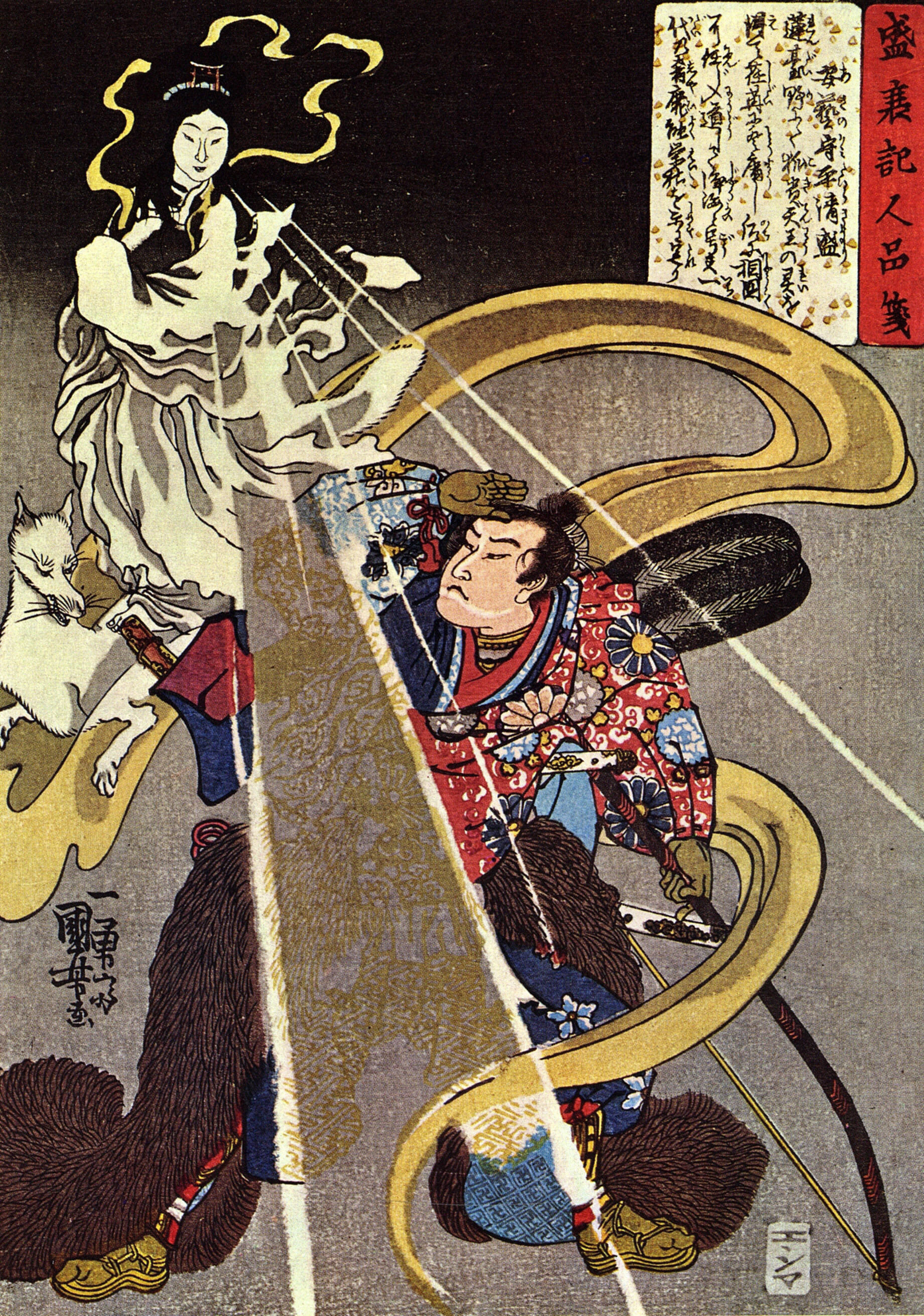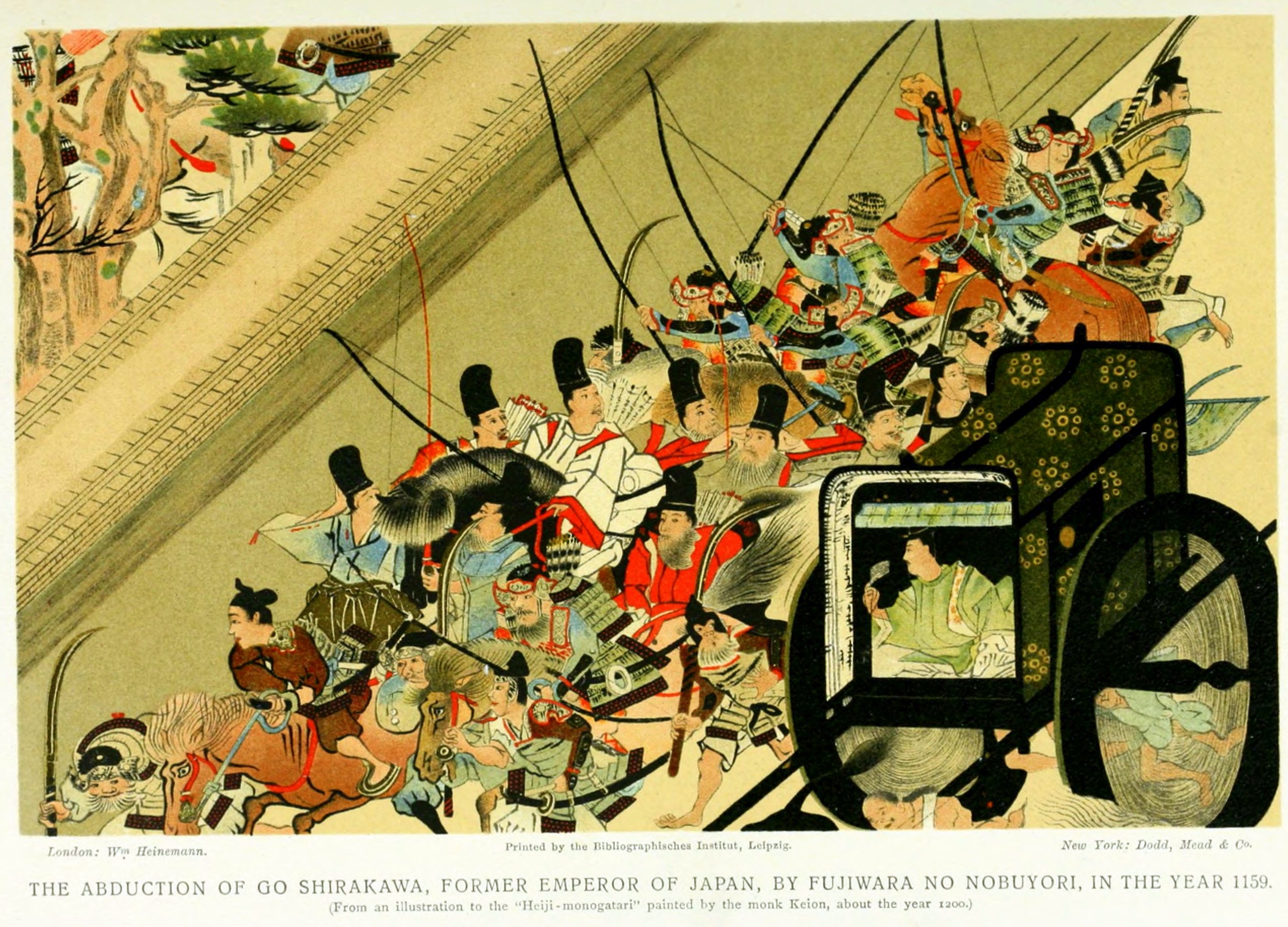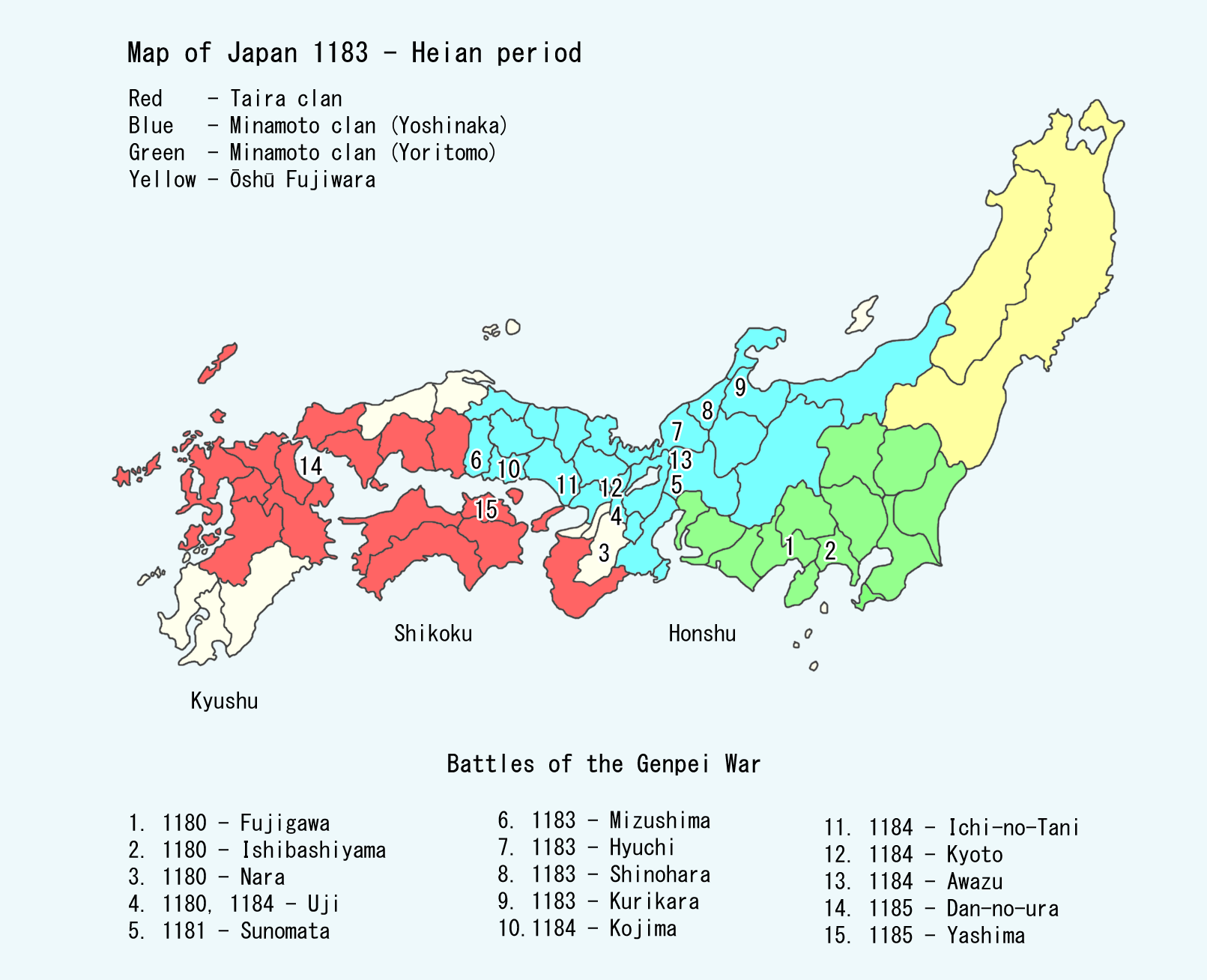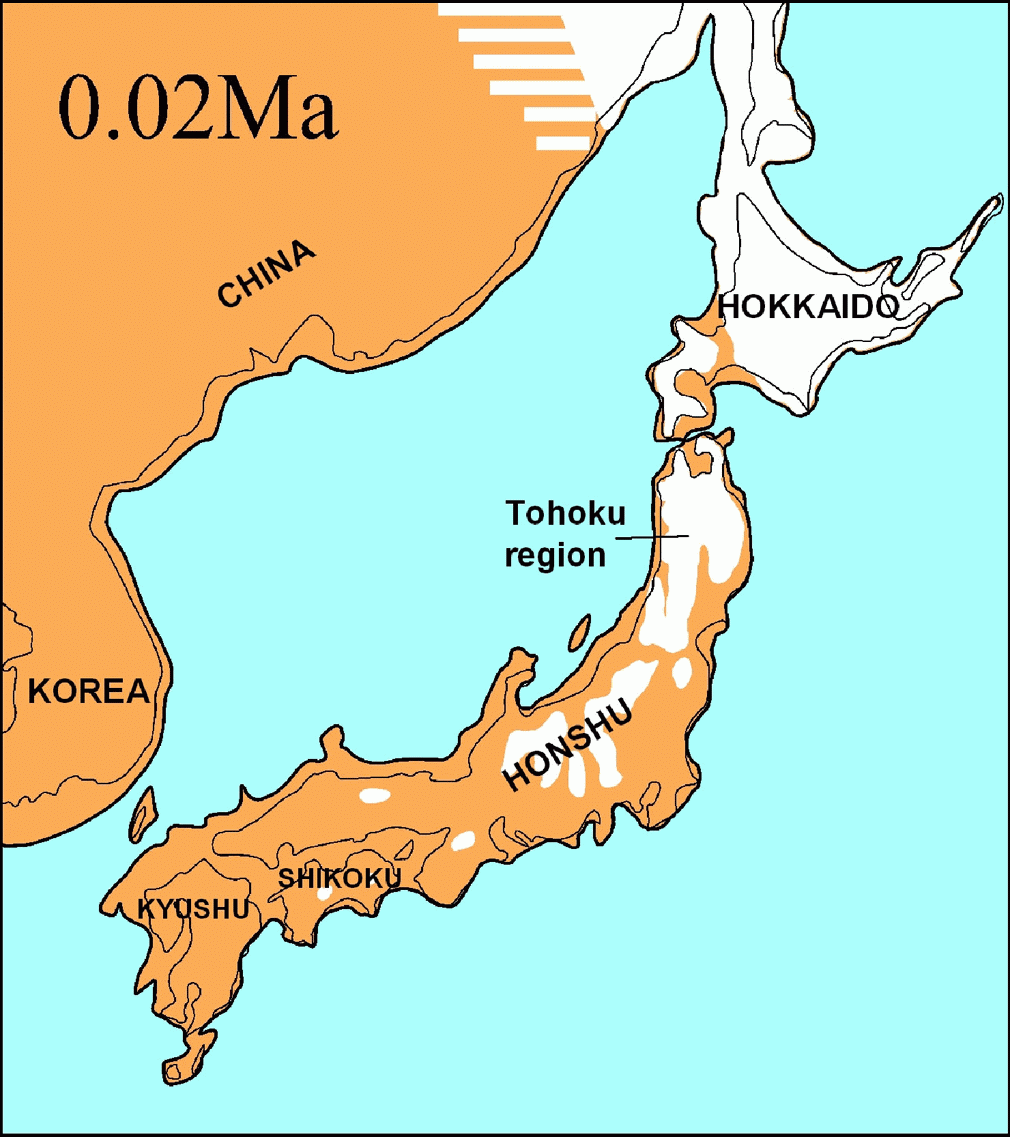|
Kiyomori
was a military leader and ''kugyō'' of the late Heian period of Japan. He established the first samurai-dominated administrative government in the history of Japan. Early life Kiyomori was born in Japan, in 1118 as the first son of Taira no Tadamori. His mother, Gion no Nyogo, was wife of Tadamori and a palace servant according to ''The Tale of the Heike''. Family Father: Taira no TadamoriMother: Gion no Nyogo (d. 1147)Concubine(s): Taira no TokikoChildren: * Taira no Shigemori * Taira no Munemori * Taira no Tomomori * Taira no Tokuko * Taira no Shigehira Career After the death of his father in 1153, Kiyomori assumed control of the Taira clan and ambitiously entered the political realm, in which he had previously only held a minor post. Before that though, in 1156, he and Minamoto no Yoshitomo, head of the Minamoto clan, suppressed the rebels in the Hōgen Rebellion. This established the Taira and Minamoto as the top samurai clans in Kyoto. However, this caused the alli ... [...More Info...] [...Related Items...] OR: [Wikipedia] [Google] [Baidu] |
The Tale Of The Heike
is an epic account compiled prior to 1330 of the struggle between the Taira clan and Minamoto clan for control of Japan at the end of the 12th century in the Genpei War (1180–1185). It has been translated into English at least five times. The first translation was by Arthur Lindsay Sadler, in 1918–1921. A complete translation in nearly 800 pages by Hiroshi Kitagawa & Bruce T. Tsuchida was published in 1975. It was also translated by Helen McCullough in 1988. An abridged translation by Burton Watson was published in 2006. In 2012, Royall Tyler completed his translation, which, he says, seeks to be mindful of the performance style for which the work was originally intended. Historical novelist Eiji Yoshikawa published a prose rendering in the '' Asahi Weekly'' in 1950, under the title ' (''Shin Heike Monogatari''). Background Title Heike () refers to the Taira (), ''hei'' being the ''on'yomi'' reading of the first ''kanji'' and "ke" () meaning "family". However, in t ... [...More Info...] [...Related Items...] OR: [Wikipedia] [Google] [Baidu] |
Taira No Kiyomori
was a military leader and '' kugyō'' of the late Heian period of Japan. He established the first samurai-dominated administrative government in the history of Japan. Early life Kiyomori was born in Japan, in 1118 as the first son of Taira no Tadamori. His mother, Gion no Nyogo, was wife of Tadamori and a palace servant according to '' The Tale of the Heike''. Family Father: Taira no TadamoriMother: Gion no Nyogo (d. 1147)Concubine(s): Taira no TokikoChildren: * Taira no Shigemori * Taira no Munemori * Taira no Tomomori * Taira no Tokuko * Taira no Shigehira Career After the death of his father in 1153, Kiyomori assumed control of the Taira clan and ambitiously entered the political realm, in which he had previously only held a minor post. Before that though, in 1156, he and Minamoto no Yoshitomo, head of the Minamoto clan, suppressed the rebels in the Hōgen Rebellion. This established the Taira and Minamoto as the top samurai clans in Kyoto. However, this ca ... [...More Info...] [...Related Items...] OR: [Wikipedia] [Google] [Baidu] |
Go-Shirakawa
was the 77th emperor of Japan, according to the traditional order of succession. His de jure reign spanned the years from Heian period, 1155 through 1158, though arguably he effectively maintained imperial power for almost thirty-seven years through the Cloistered rule, ''insei'' system – scholars differ as to whether his rule can be truly considered part of the ''insei'' system, given that the Hōgen Rebellion undermined the imperial position. However, it is broadly acknowledged that by politically outmaneuvering his opponents, he attained greater influence and power than the diminished authority of the emperor's position during this period would otherwise allow. posthumous name, Posthumously, this 12th-century sovereign was named after the 11th-century Emperor Shirakawa. ''Go-'' (後), translates literally as "later"; and thus, he is sometimes called the "Later Emperor Shirakawa", or in some older sources, may be identified as "Shirakawa, the second" or as "Shirakawa II". Unu ... [...More Info...] [...Related Items...] OR: [Wikipedia] [Google] [Baidu] |
Minamoto No Yoritomo
was the founder and the first shogun of the Kamakura shogunate, ruling from 1192 until 1199, also the first ruling shogun in the history of Japan.Nussbaum, Louis-Frédéric. (2005). "Minamoto no Yoriie" in . He was the husband of Hōjō Masako who acted as regent (''shikken'') after his death. Yoritomo was the son of Minamoto no Yoshitomo and belonged to Seiwa Genji's prestigious Kawachi Genji family. After successfully maneuvering himself to the position of rightful heir of the Minamoto clan, he led his clan against the Taira clan, Taira from his capital in Kamakura, beginning the Genpei War in 1180. After five years of civil war, the Minamoto clan finally defeated the Taira in the Battle of Dan-no-ura in 1185. Yoritomo established the supremacy of the samurai caste and the first shogunate (''bakufu'') which was to be centered around Kamakura, thus beginning the History of Japan#Feudal Japan, feudal age in Japan, which lasted until the 17th century. Early life Yoritomo was t ... [...More Info...] [...Related Items...] OR: [Wikipedia] [Google] [Baidu] |
Taira No Tokiko
was a Japanese aristocrat from the Heian period. She was the concubine of Taira no Kiyomori, mother of Taira no Tokuko, and grandmother of Emperor Antoku. Later she took the vows to become a nun, after which she was generally referred to by her Buddhist name as the . After Kiyomori's death in 1181, Tokiko's son, Taira no Munemori, became the head of the Taira clan. After this, she became the representative pillar of the Taira clan. According to ''The Tale of the Heike'', Taira no Tokiko drowned herself during the Battle of Dan-no-ura together with her grandson, Taira no Tokushi. Life It is speculated that she was taken as Kiyomori's concubine around the year 1145, based on the birth year of her first child, Munemori. After the Heiji Rebellion, she became the wet nurse of Emperor Nijō's son, and on December 24, 1160, she was promoted to Jusanmi by the recommendation of Yaso no Tsubone. Her role as the wet nurse of Emperor Nijō and Kiyomori's status as the foster father were ... [...More Info...] [...Related Items...] OR: [Wikipedia] [Google] [Baidu] |
Taira No Tokuko
, later known as , was the daughter of Taira no Kiyomori and Taira no Tokiko. She was empress consort of Emperor Takakura. Tokuko was also the last Imperial survivor from the great naval battle of Dan-no-ura. Her life became a compelling narrative which survives as both history and literature. In history Daughter of an emperor Tokuko became the adopted daughter of , the 77th emperor of Japan who reigned from 1155 through 1158. In 1171, when Tokuko was 17, the emperor had abdicated the throne and entered the Buddhist priesthood, taking the Buddhist name of Gyōshin. Consort of an emperor In 1172, Tokuko was married to Go-Shirakawa's fourth and only surviving son, Emperor Takakura. Takakura was also her first cousin as both their mothers were half-sisters. The wedding was an arranged one, as to cement the alliance between the two co-fathers-in-law; Go-Shirakawa sponsored Kiyomori's rise as Chancellor of the Realm, while Kiyomori provided military and financial support ... [...More Info...] [...Related Items...] OR: [Wikipedia] [Google] [Baidu] |
Taira No Kiyomori Kao
The was one of the four most important clans that dominated Japanese politics during the Heian period of Japanese history – the others being the Minamoto, the Fujiwara, and the Tachibana. The clan is divided into four major groups, named after the emperors they descended from: Kanmu Heishi, Ninmyō Heishi, Montoku Heishi, and Kōkō Heishi, the most influential of which was the Kanmu Heishi line. In the twilight of the Heian period, the Taira controlled the boy emperor Antoku (himself the grandson of the powerful ''Kugyō'' Taira no Kiyomori) and had effectively dominated the Imperial capital of Heian. However, they were opposed by their rivals the Minamoto clan (the Genji), which culminated in the Genpei War (1180–1185 AD). The five-year-long war concluded with a decisive Taira defeat in the naval Battle of Dan-no-Ura, which resulted in the deaths of Antoku and Taira leaders. Following the war, the victorious Minamoto established Japan's first shogunate in Kamakura. ... [...More Info...] [...Related Items...] OR: [Wikipedia] [Google] [Baidu] |
Taira
The was one of the four most important clans that dominated Japanese politics during the Heian period of Japanese history – the others being the Minamoto, the Fujiwara, and the Tachibana. The clan is divided into four major groups, named after the emperors they descended from: Kanmu Heishi, Ninmyō Heishi, Montoku Heishi, and Kōkō Heishi, the most influential of which was the Kanmu Heishi line. In the twilight of the Heian period, the Taira controlled the boy emperor Antoku (himself the grandson of the powerful ''Kugyō'' Taira no Kiyomori) and had effectively dominated the Imperial capital of Heian. However, they were opposed by their rivals the Minamoto clan (the Genji), which culminated in the Genpei War (1180–1185 AD). The five-year-long war concluded with a decisive Taira defeat in the naval Battle of Dan-no-Ura, which resulted in the deaths of Antoku and Taira leaders. Following the war, the victorious Minamoto established Japan's first shogunate in Kamaku ... [...More Info...] [...Related Items...] OR: [Wikipedia] [Google] [Baidu] |
Heian Period
The is the last division of classical Japanese history, running from 794 to 1185. It followed the Nara period, beginning when the 50th emperor, Emperor Kammu, moved the capital of Japan to Heian-kyō (modern Kyoto). means in Japanese. It is a period in Japanese history when the Chinese influence on Japanese culture, Chinese influences were in decline and the national culture matured. The Heian period is also considered the peak of the Japanese Emperors of Japan, imperial court, noted for its Japanese art, art, especially Japanese poetry, poetry and Japanese literature, literature. Two syllabaries unique to Japan, katakana and hiragana, emerged during this time. This gave rise to Japan's famous vernacular literature, with many of its texts written by court ladies who were not as educated in Chinese as their male counterparts. Although the Imperial House of Japan had power on the surface, the real power was in the hands of the Fujiwara clan, a powerful Kuge, aristocratic family wh ... [...More Info...] [...Related Items...] OR: [Wikipedia] [Google] [Baidu] |
Hōgen Rebellion
The was a short civil war fought in order to resolve a dispute about Japanese Imperial succession. The dispute was also about the degree of control exercised by the Fujiwara clan who had become hereditary Imperial regents during the Heian period. ''Hōgen no ran'' produced a series of unanticipated consequences. It created a foundation from which the dominance of the samurai clans would come to be established. It is considered the beginning in a chain of events which would produce the first of three samurai-led governments in the history of Japan. Context A simmering power struggle in the Imperial court was focused on three figures in 1155. After the former Emperor Toba and the former Emperor Sutoku abdicated, each intended to continue to wield various kinds of power behind the throne during the reign of Emperor Konoe in cloistered rule. However, when young Konoe died, the dynamics of the contending factions changed. * August 23, 1155 ('' Kyūju 2, 24th day of the 7t ... [...More Info...] [...Related Items...] OR: [Wikipedia] [Google] [Baidu] |
History Of Japan
The first human inhabitants of the Japanese archipelago have been traced to the Japanese Paleolithic, Paleolithic, around 38–39,000 years ago. The Jōmon period, named after its cord-marked pottery, was followed by the Yayoi period in the first millennium BC when new inventions were introduced from Asia. During this period, the first known written reference to Japan was recorded in the Chinese ''Book of Han'' in the first century AD. Around the 3rd century BC, the Yayoi people from the continent immigrated to the Japanese archipelago and introduced iron technology and agricultural civilization. Because they had an agricultural civilization, the population of the Yayoi began to grow rapidly and ultimately overwhelmed the Jōmon period, Jōmon people, natives of the Japanese archipelago who were hunter-gatherers. Between the fourth and ninth centuries, Japan's many kingdoms and tribes gradually came to be unified under a centralized government, nominally controlled by the Empe ... [...More Info...] [...Related Items...] OR: [Wikipedia] [Google] [Baidu] |
Minamoto No Yoshitomo
(1123 – 11 February 1160) was the head of the Minamoto clan and a general of the late Heian period of Japanese history. His son Minamoto no Yoritomo became ''shōgun'' and founded the Kamakura shogunate, the first shogunate in the history of Japan. His Dharma name was Shōjō Juin (勝定寿院). Hōgen Rebellion With the outbreak of the Hōgen Rebellion in 1156, the members of the Minamoto and Taira samurai clans were called into the conflict. Yoshitomo and Taira no Kiyomori both threw their support behind Emperor Go-Shirakawa and Fujiwara no Tadamichi, while Yoshitomo's father, Minamoto no Tameyoshi, sided with the retired Emperor Sutoku and Fujiwara no Yorinaga. Yoshitomo, defeating his father and the forces of Sutoku and Yorinaga, became head of the Minamoto clan and established himself as the main political power in the capital of Kyoto. However, despite attempts to have his father pardoned, Tameyoshi was executed. In the aftermath of the rebellion, the Taira a ... [...More Info...] [...Related Items...] OR: [Wikipedia] [Google] [Baidu] |







